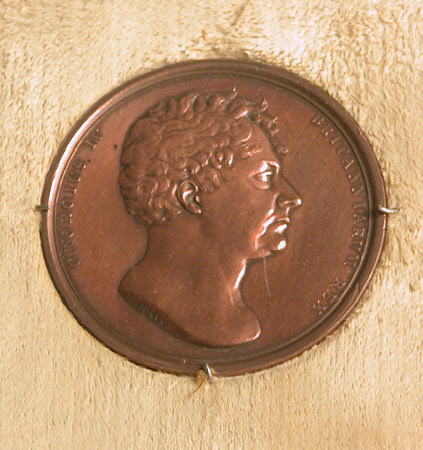Coronation Medal of King George IV commemorating the ceremony of the King’s Champion
George Mills (1792 - 1824)
Category
Coins and medals
Date
1821
Materials
Bronze
Measurements
55.3 mm (Diameter)
Place of origin
London
Order this imageCollection
Anglesey Abbey, Cambridgeshire
NT 517662.2
Summary
Bronze, King George IV (1762-1830), George Mills (1792-1824), 1821. A bronze medal by George Mills, celebrating the performance of the ceremony of King’s Champion at the Coronation of King George IV, on 19 July 1821. The obverse has the bust of the king in profile facing to the right, with the translated legend ‘George IV King of [Great] Britain’. On the truncation the artist’s signature. On the reverse is a caparisoned knight in armour on horseback, facing left, representing Henry Dymoke (1801-65), the King’s Champion. The legend reads in translation ‘I fight for the Sovereign’ and, in the exergue, ‘Crowned on 19 July 1821.’ Mounted in a frame with ten other medals and tokens commemorating and celebrating King George IV (1762-1830, reigned 1820-30) (NT 517662).
Full description
The Coronation of King George IV, in Westminster Abbey, on 19 July 1821, was an astonishingly extravagant and over-the-top affair, fully in keeping with the new monarch’s reputation for expensive high-living. The cost of George IV’s Coronation was £250,000, his robes alone costing £25,000. In contrast, ten years later just £50,000 was spent on the Coronation of King William IV. One of the high points of George IV’s Coronation was the last-ever appearance, at a Coronation in Britain, of the medieval ceremony of the monarch’s champion. The King’s Champion was tasked with engaging to fight on behalf of the monarch, should a challenge be received. There is no record of this ever having actually happened so that, in fact, the role of the Champion at Coronations has always been a purely ceremonial one. The Champion would ride into the banquet traditionally held directly after the Coronation, in full armour, and would then swear to defend his king or queen ‘by his body, if necessary’, issuing a challenge to anyone who dared to question the monarch’s right to rule. The King’s Champion has since 1377 been hereditary, tied to the lordship of the manor of Scrivelsby in Lincolnshire, held by the Dymoke family. The Coronation of George IV was the last time that the King’s Champion made such an entrance. The knight on this occasion was Henry Dymoke (1801-65), standing in for his father the Rev. Mr. John Dymoke. The event was described in detail in the Gentleman’s Magazine (1821, vol. II, pp. 15-16). It took place in Westminster Hall, where a banquet was held for 300 guests, with special galleries built for more spectators. Following the first course, after a flourish of trumpets the great doors of the Hall opened, to allow the Champion to appear, in full armour and mounted on a pie-bald charger. On either side of him, also on horseback, were the Duke of Wellington and Lord Howard of Effingham, with the three horsemen being accompanied by a cavalcade of followers, including two trumpeters and two squires in half-armour, bearing the Champion’s lance and his shield. The Champion issued the same challenge three times: on entering the Hall, half-way up and, finally, before the King. After a flourish of trumpets the accompanying Herald would read this statement: ‘If any person, of what degree soever, high or low, shall deny or gainsay our Sovereign Lord King George the Fourth, of the United Kingdom of Great Britain and Ireland, Defender of the Faith, son and next heir to our sovereign lord King George the Third, the last King deceased, to be right heir to the Imperial Crown of this United Kingdom, or that he ought not to enjoy the same, here is his Champion, who saith that he lieth, and is a false traitor; being ready in person to combat with him, and in this quarrel will adventure his life against him, on what day soever shall be appointed.’ The Champion then threw his gauntlet to the floor. Nobody having responded to the challenge by picking it up, it was collected by the Herald and returned to the Champion. Great cheers of ‘Long live the King’ erupted on each occasion when the gauntlet was retrieved. Finally, the King and the Champion drank to one another from a gold cup, that was carried away by a page and presented to Henry Dymoke, as the Champion’s perquisite [gift = the modern word ‘perk’]. This extraordinary ceremony, which reflected the surge in interest in the history of the Middle Ages and in arms and armour during the first decades of the nineteenth century, was recorded in a watercolour by Denis Dighton (Royal Collection, RCIN 913630), as well as in the present medal which shows Henry Dymoke in armour upon his steed which, according to the Gentleman’s Magazine, ‘was considerably alarmed by the noise’ of the trumpets and shouts and cheers. The legend, Pro Rege Dimico (‘I fight for the Sovereign’) is the motto of the Dymoke family and forms a pun on their name. Jeremy Warren, 2020
Provenance
Bequeathed to the National Trust by Huttleston Rogers Broughton, 1st Lord Fairhaven (1896-1966) with the house and the rest of the contents in 1966.
Credit line
National Trust Collections (Anglesey Abbey, The Fairhaven Collection)
Marks and inscriptions
Obverse: Legend: GEORGIUS IV / BRITANNIARUM REX Artist’s signature, on truncation: MILLS Reverse: Legend: PRO REGE DIMICO In exergue: CORONAT JULII XIX / MDCCCXXI Artist’s signature, above exergue rail line, at right: MILLS F
Makers and roles
George Mills (1792 - 1824), medallist
References
Brown 1980: Laurence Brown, A catalogue of British historical medals 1760-1960, Vol.I. The accession of George III to the death of William IV, London 1980, p. 267, no. 1087 Eimer 2010: Christopher Eimer, British Commemorative Medals and their Values, London 2010, p. 160, no. 1142, Pl. 125
